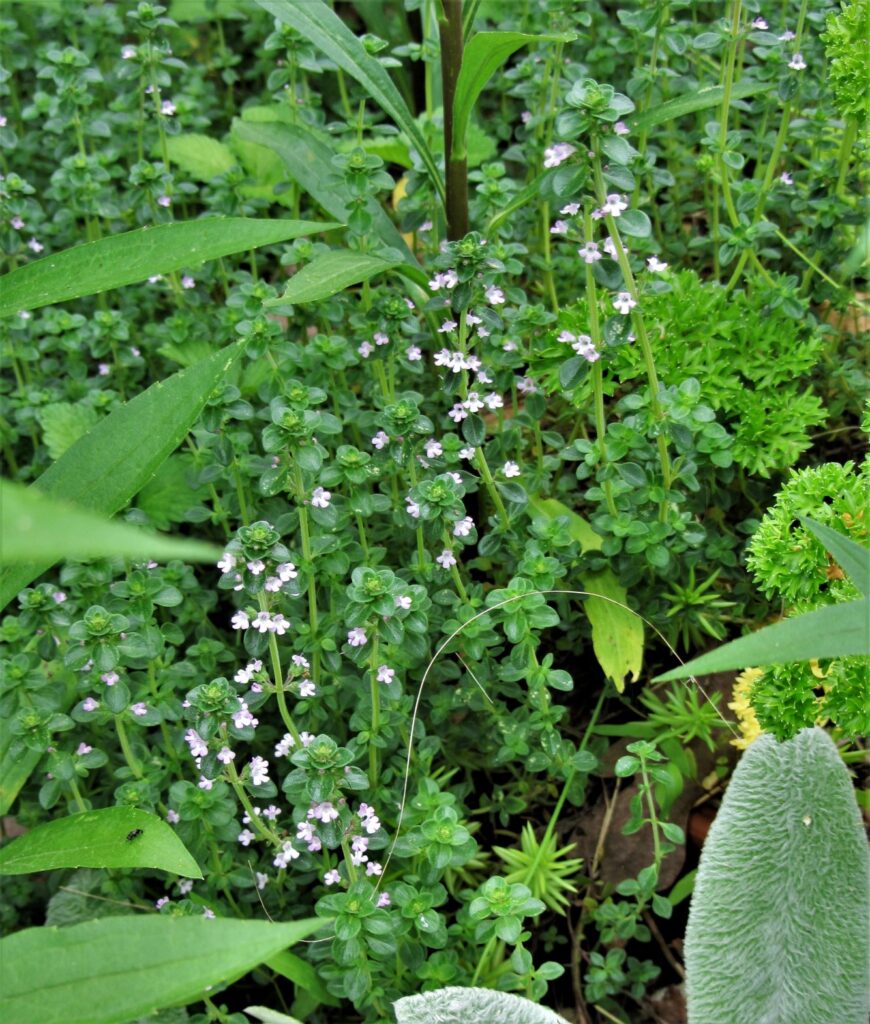Magical Thyme
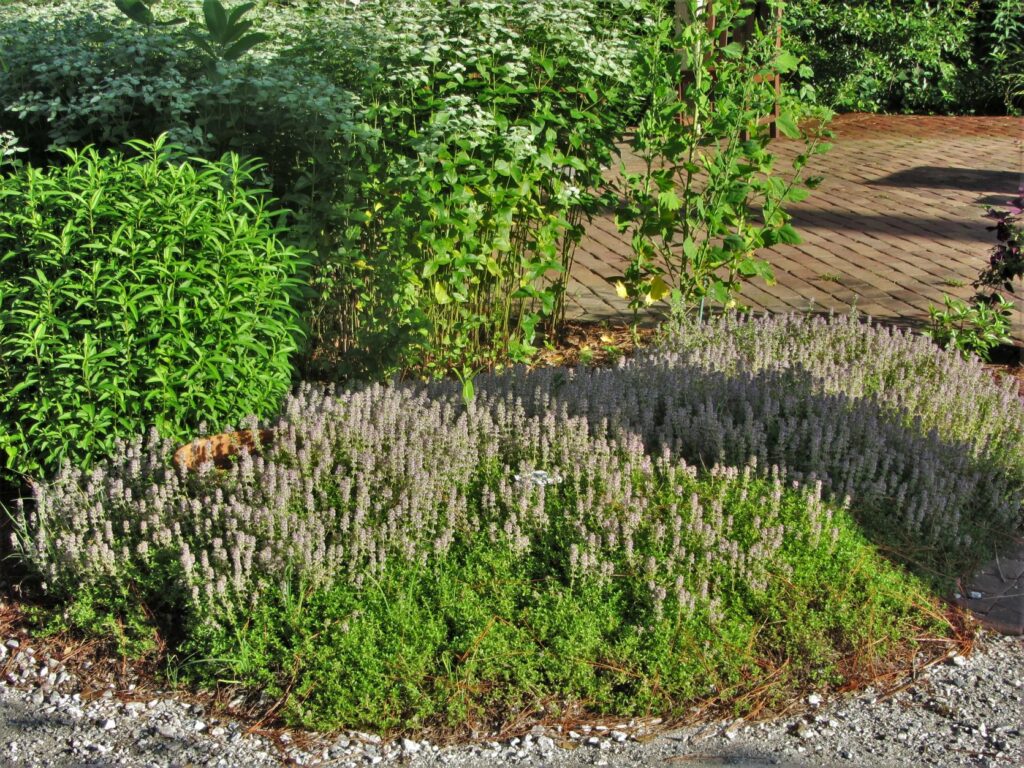
Thyme grows into an excellent ground cover in the herb garden of the Williamsburg Botanical Garden and Freedom Park Arboretum. It is attractive to bees and other pollinators and produces delicious honey.
“I know a bank where the wild thyme blows,
Where oxlips and the nodding violet grows,
Quite over-canopied with luscious woodbine,
With sweet musk-roses and with eglantine:
There sleeps Titania sometime of the night,
Lull’d in these flowers with dances and delight;
And there the snake throws her enamell’d skin,
Weed wide enough to wrap a fairy in:”William Shakespeare, from A Midsummer Night’s Dream
Magical Thyme
If you are wanting to conjure a bit of magic in your garden this summer, plant thyme. Thyme is a magical herb with a long history and a multitude of uses. Whether you need courage, want to soothe your sore throat, banish nightmares, produce honey, or simply make a great salad dressing, thyme will serve you well.
Thyme is one of those plants so important in its native territory, around the Mediterranean Sea, that it was cultivated, and the best plants selected and propagated for its usefulness, by the ancients. You’ll find mentions of its uses and properties on the cuneiform tablets of the Sumerians and in works written by ancient Egyptians, Greeks, and Romans. Its uses are detailed in European grimoires and herbal medical books compiled during the Middle Ages. It was grown in temple and monastery gardens, around villas and castles, and still thrived, wild, on the hillsides of Greece, Portugal, and Spain. It spread far and wide in ancient times. We know that thyme was commonly grown in England by the mid-16th century and was brought here to the New World by European colonists.
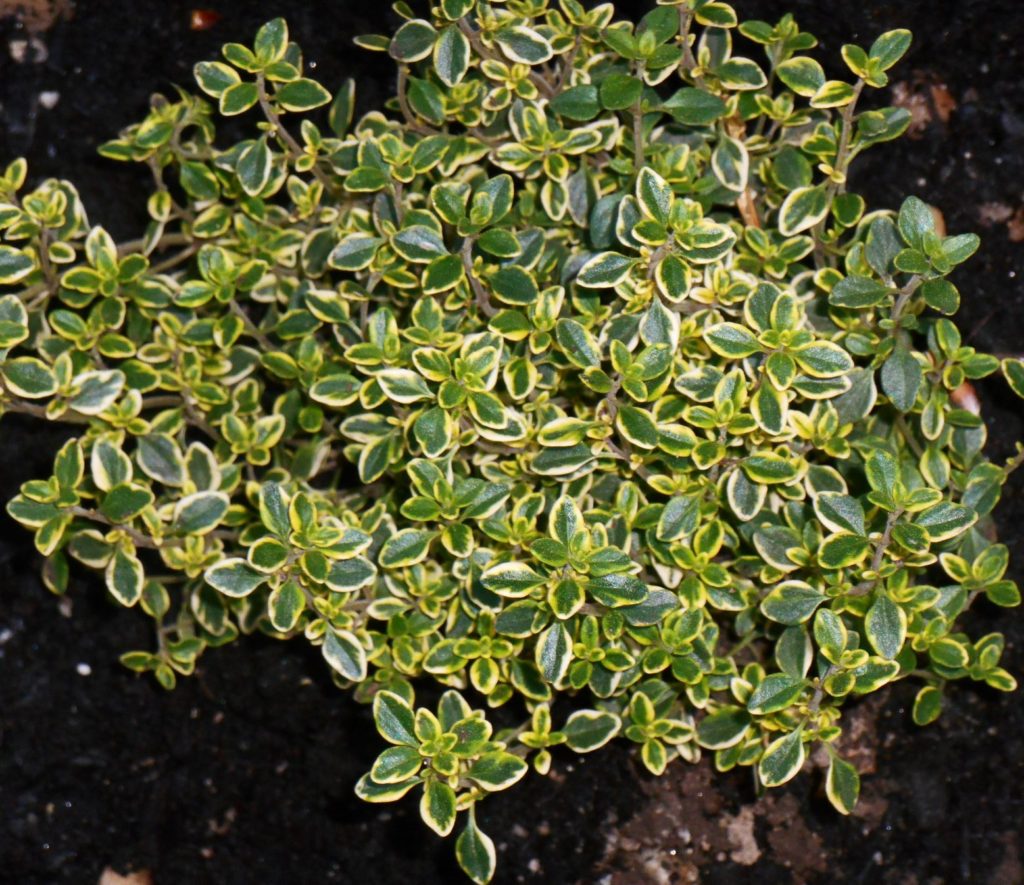
Variegated lemon thyme, Thymus citriodorus
Fragrance and Healing Powers
Thyme may have the smallest leaves of any herb we grow. It grows humbly underfoot or at the edges of a bed or pot. But pause to run your fingertips through its glossy, evergreen leaves and you will release a cloud of fragrance.
That fragrance comes from the essential oil found in thyme, which is the source of much of thyme’s magic. Thyme contains thymol which has proven to be antiseptic, antibacterial, antiviral, antifungal, and anti-inflammatory. The same essential oils which help clear upper-respiratory infections were found useful by Egyptian priests as they cured the living and embalmed their dead. Today you might find thymol listed in several drugstore remedies, including cough drops, toothpaste, and mouthwash. It can relieve headaches, and thyme also aids digestion. It comes from the most common Thymus vulgaris, which is the same thyme we use in cooking.
Thyme’s essential oils are released when fresh or dried thyme soaks in certain liquids. Soak thyme leaves in boiling water to brew herbal tea. Brew them in simple syrup, or with honey, to make a treatment for respiratory and throat ailments. Add sprigs of thyme to vinegars or oils, and let them develop for days or weeks, to make gourmet products for medicinal or culinary uses. Add thyme to pure, potable alcohol such as vodka, or to wine, for a flavored beverage. Simmer thyme leaves in melted beeswax, mixed with other oils, essential oils, and herbs to make skin salves and ointments.
Types of Thyme
There are over 300 species of thyme, plus many more named varieties and hybrids in the genus Thymus. The most common species available to us at local nurseries are T. vulgaris, also known as garden thyme; T. serpyllum, known as creeping thyme, wild thyme, or mother of thyme; T. praecox, known as woolly or creeping thyme; and T. citriodorus, known as lemon thyme. T. vulgaris and T. citriodorus are both used in cooking and in preparing medications. T. serpyllum and T. praecox are used as ground cover and ornamental plants in the garden, but normally aren’t the best choices for consumption. All are excellent for sustaining bees, butterflies, and other pollinators.
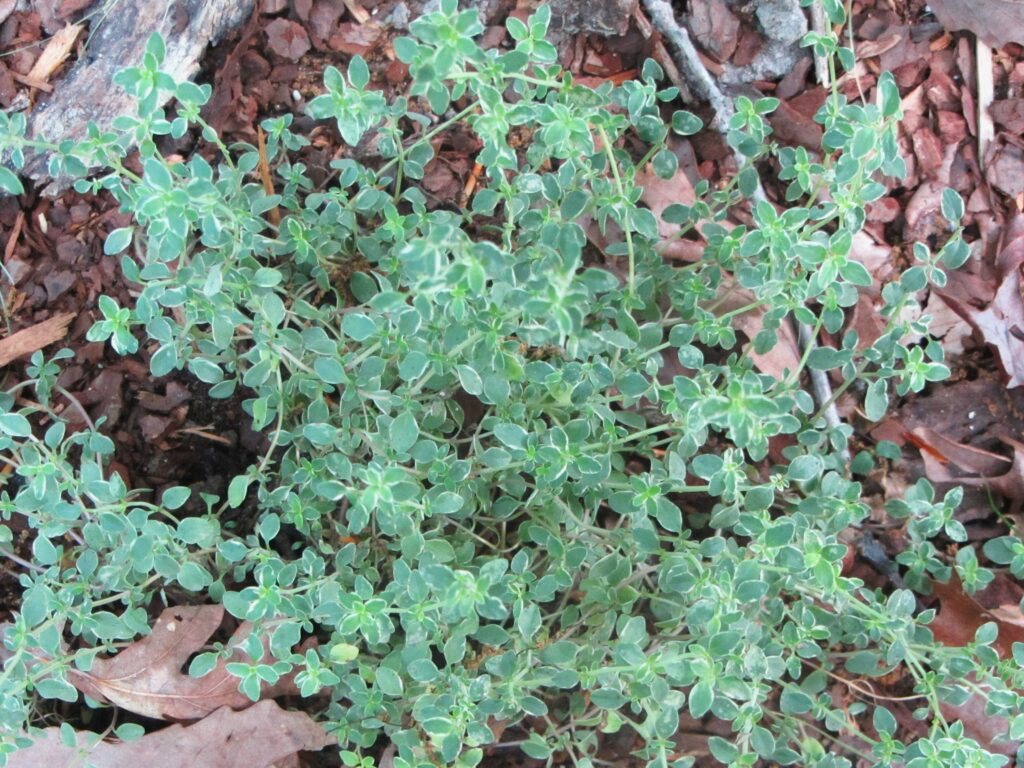
There are many good selections of variegated T. vulgaris. Choose thyme plants by leaf color and design for ornamental use, by fragrance for culinary use.
Myth and Meaning
The genus name Thymus may have come from the Greek ‘thumos,’ which means courage, or from the Greek ‘thymos,’ which means perfume. Thyme is strongly associated with courage in all the battles of life. Ancient warriors carried sprigs of thyme into battle, and ladies embroidered sprigs of thyme with attending bees onto the scarves they gave to their champions. Soldiers used crushed thyme leaves and medicines made from thyme and olive oil to heal and disinfect wounds.
People from many cultures used thyme to maintain their own hygiene and as a symbol of grace and beauty. Thyme was sacred to ancient goddesses, including Demeter and Aphrodite. Women wore sprigs of thyme to enhance their beauty and attractiveness.
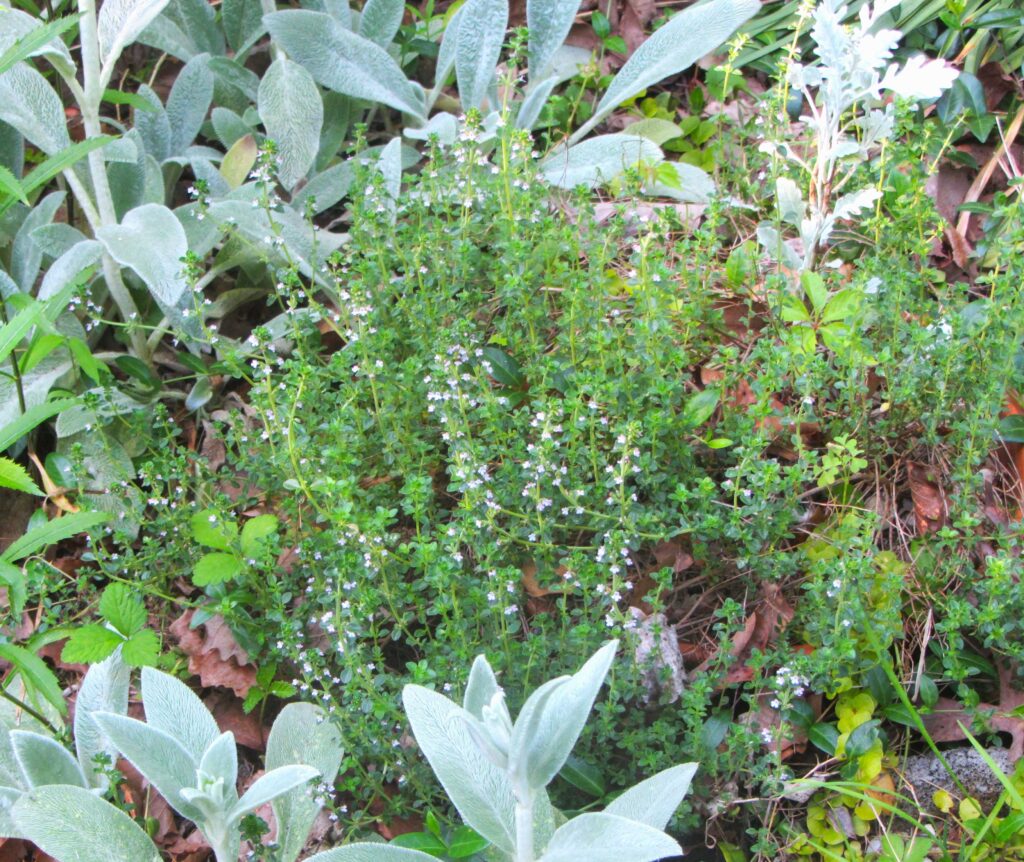
Provide thyme with the neutral to sweet soil it prefers by growing it in a hypertufa container, or plant it near concrete pavers or sidewalks.
‘Green Magic’
Modern practitioners of ‘green magic’ may hang sprigs of dried thyme in their cars or keep thyme in their homes and offices. The scent of thyme is said to strengthen one and lend courage, clarity, and strength of purpose. It is a common herb used in funerary rites, carried by mourners, and sometimes even tossed into a grave just before the grave is closed to lend courage to the departed one on their journey.
Thyme is one of the oldest types of incense. Dried thyme may be thrown into a fire or burned more slowly over charcoal to release its fragrance. Bundles of dried thyme are burned like bundles of sage to ‘smudge’ a space to clear out stale or negative energy, bring happiness, and to protect one’s home. Burning bundles of thyme has deep roots in indigenous religious practice and ceremony.
Fairy lore holds that thyme plants are a favorite of ‘the other folk,’ and that planting thyme invites them into your garden to help tend the plants. Shakespeare tells us that the Titania, the Queen of Faerie, slept in a patch of thyme.
Thyme is a common ingredient in sachets and potpourri. Sprigs of thyme may be tucked into dresser drawers, like cedar wood or lavender, to keep stored clothing fresh and insect free. Add a sprig of fresh thyme between pillow and pillowcase for sweeter dreams.

Grow thyme among other herbs that share similar cultural needs. Thyme grows here with oregano and basil, herbs often used together in recipes. The Williamsburg Botanical Garden and Freedom Park Arboretum August 2021.
Cooking With Thyme
Thyme is also useful in the kitchen. It is a key ingredient in marinades for chicken or fish mixed with lemon juice, pepper, and olive oil. Classic Greek salad dressing features dried thyme, along with salt and pepper, in a simple vinaigrette of olive oil, lemon juice, and red wine vinegar. Add thyme to skewers of meat or lay fresh sprigs onto meat or vegetables as they cook on the grill. Dried thyme is a main ingredient of the spice blend Za’atar, along with sesame seeds, sumac, and oregano. This spice blend is sometimes known as ‘brain food’ for its medicinal boost.
Thyme is added to roasts, soups, stews, stir fries, and spice rubs. Add it to scrambled eggs or cream cheese spreads. Add fresh or dried thyme to bread dough or blend it into softened butter. Make sugar cookies or shortbread with thyme leaves and lemon zest for a healthy treat. Sprigs of flowering thyme may also be added to salads and fruit plates.
Dried thyme leaves are brewed as tea to calm the nerves and help one relax, or to soothe a sore throat. Stir in some honey, which is often thyme’s companion, and some lemon for extra flavor and healing benefits. Thyme has been cultivated in various flavors, including lemon, orange, nutmeg, and caraway. While lemon and caraway thyme are now listed as a separate species, most of the flavored and variegated varieties of thyme are derived from T. vulgaris.
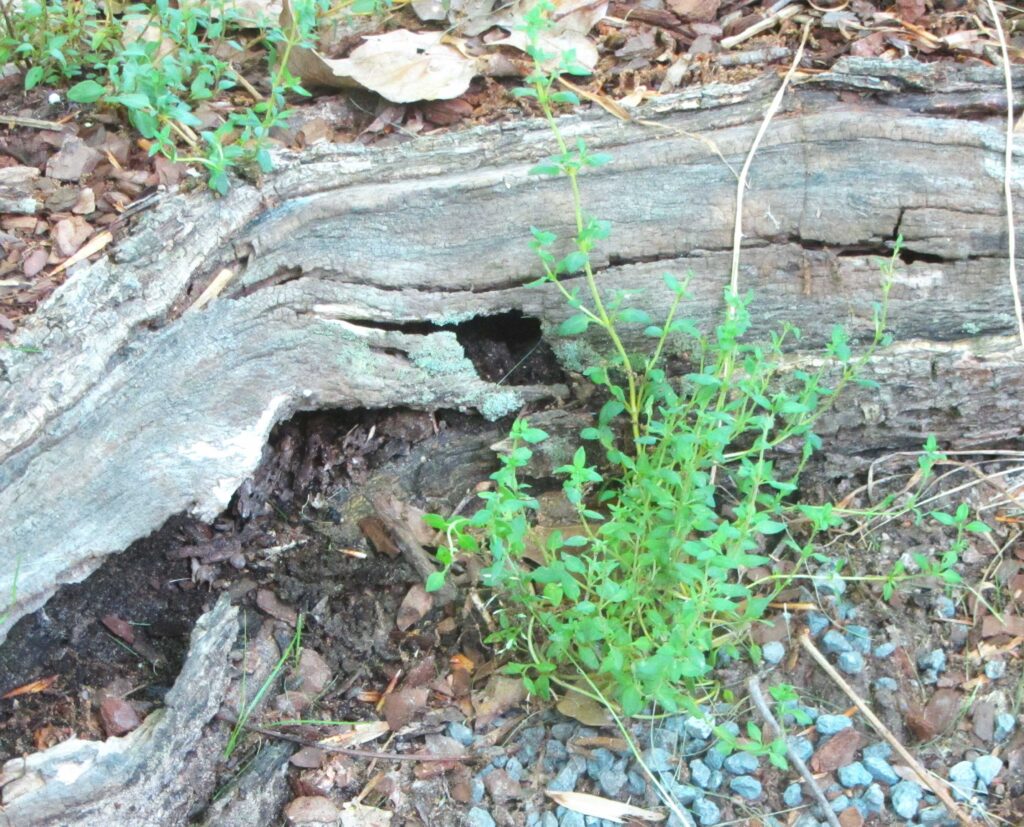
Thyme plugs in 4 packs or 6 packs are widely available in early spring. This ‘winter’ thyme has long narrow leaves and a pungent fragrance, and will grow in to make a ground cover around a larger planting.
Thyme in a Garden
Thyme, like so many Mediterranean herbs, is a member of the mint, or Lamiaceae family. It has tiny flowers and blooms in shades of white, blue, and pink from May through late summer. It grows more woody with age and has woody roots. Gardeners can renew aging plants and prolong flowering with frequent pruning, especially in early spring. While thyme is hardy in Zones 5-9, and often evergreen in coastal Virginia (Zone 8) it may look a bit ratty by March. A hard pruning, once cold weather has passed, stimulates new growth.
Thyme’s natural, historic habitat is on the hillsides of Greece, and other European and North African countries, where it grows wild in dry, rocky soil in full sun. It prefers sweet or neutral soil, requires sharp drainage, and hates sitting in wet soil. Thyme grows wild on very lean and poor soil, and even on sand. Give thyme at least 6 to 8 hours of full sun daily for best performance and bloom. It will grow in partial shade but grows leggier and has less vibrant colors.

Lemon thyme remains evergreen much of the year and can be harvested for cooking and other uses year-round.
Keep Your Thyme Happy
Where soil stays damp, grow thyme on a sunny slope, in a raised bed, or a container. If your soil is more acidic, there are several ways to keep your thyme happy. Lime lowers the pH of soil, making an acidic soil more neutral, but one can also plant thyme with pea gravel or limestone mulch, plant it near cement pavers or edging blocks, or spread crushed or whole seashells, like oyster shells, around the planting. If you have heavy clay soil, you can dig in sand, perma-till, or even add pea gravel before planting. Gravel or shell mulch protects thyme’s stems and leaves from contact with wet soil and water borne microbes. This can really help plants grown in areas with heavy or frequent rain. Even when grown in containers, thyme will benefit from pea gravel or perma-till mulch to keep its roots cool and foliage clean.
Lavender and thyme are great companion plants because they thrive in the same conditions. While thyme remains low in stature, it will easily spread into a wide mat. Each stem roots from the joints where new leaves grow. Help this process along by pushing a stem into the soil lightly where you want it to root and place a small stone over the stem to hold it in place.
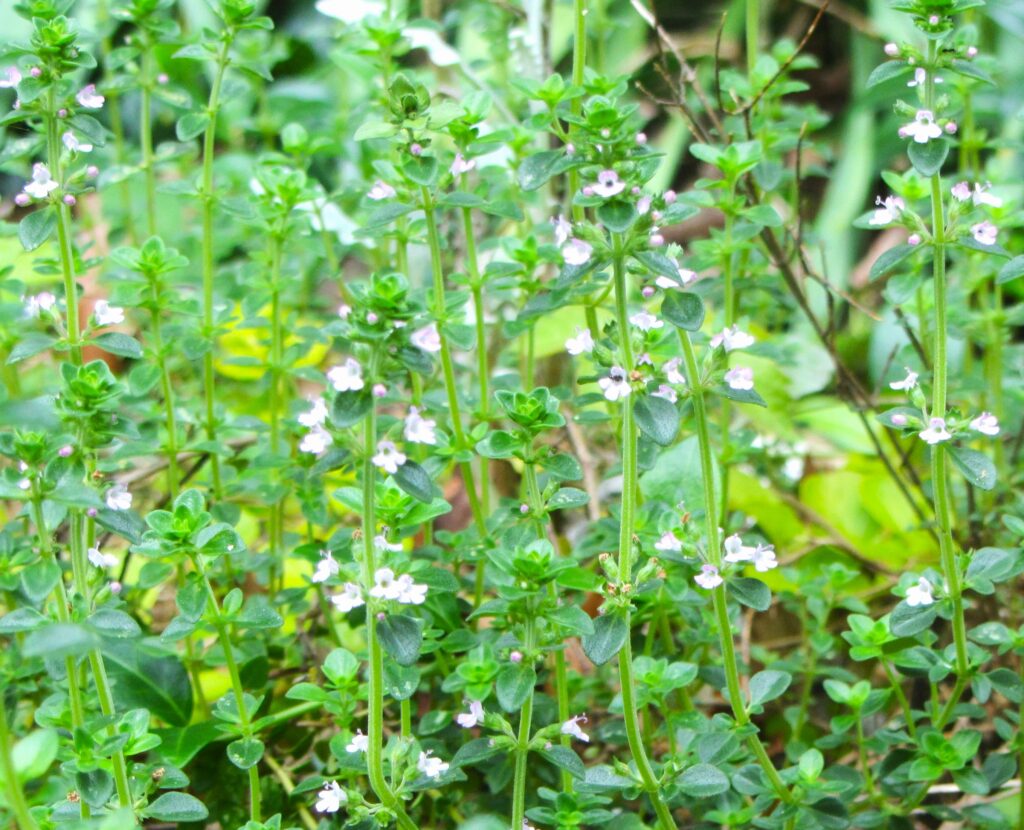
A thyme stem will produce roots from each leaf axil where pairs of leaves grow from the stem. Strip the lower two pairs of leaves, and any flowers, from a cutting before sticking it in moist soil or leaving it in a jar of water. New roots will grow where the leaves were stripped away.
Propagating Thyme
Root cuttings of thyme in damp soil or in water. Divide older plants, making sure that each division has some roots and healthy growth. Thyme seeds are tiny, but thyme may self-seed near mature plants. Most gardeners buy small plants in growth because all the desirable varieties aren’t available as seeds, and the tiny seedlings may be challenging to handle. You can sow seeds where you want them to grow by mid-March, and thin the plants as they grow.
The Charm of Thyme in Sustainable Gardens
Thyme is an excellent addition to sustainable, wildlife friendly landscapes. Deer and rabbits rarely touch it because of its strong fragrance and flavor. It rarely needs irrigation or fertilizer once established and requires very little care. No chemicals are needed to maintain it. Gardeners may plant thyme on the edges of beds and borders to discourage deer from grazing other nearby plants.
Thyme once grew abundantly and wild across much of Europe and northern Africa and proved so useful that migrants carried it with them wherever they moved. This easy to grow and versatile plant lends a bit of magic and mystique to our modern gardens, too. The more we learn to use thyme, the more its ‘green magic’ charms our lives and our gardens.
All photos by E. L. McCoy
For More Information:
Dutton, Joan Parry. Plants of Colonial Williamsburg – How to Identify 200 of Colonial America’s Flowers, Herbs and Trees. The Colonial Williamsburg Foundation. 1979.
Grieve, Mrs. M. A Modern Herbal in Two Volumes, Volume II I-Z. Harcourt, Brace, & Company. 1931.
Keville, Kathi, and Jeffrey Laign. Complete Book of Herbs, Using Herbs to Enrich Your Garden Home, and Health. Publications International, Ltd. 1997.
Halpin, Anne M. editor. Rodale’s Home Gardening Library Herbs. Rodale Press. 1988.
Hopkinson, Patricia, Diane Miske, Jerry Parsons, Holly Shimizu, and Kathy Sammis. Herb Gardening. Pantheon Books, Knopf Publishing Group. 1994.
Ogden, Shepherd and Ellen Ogden. The Cook’s Garden, Growing and Using the Best-Tasting Vegetable Varieties. Rodale Press. 1989.
Rago, Linda Ours. Dooryard Herbs. Carabelle Books. 1984.

